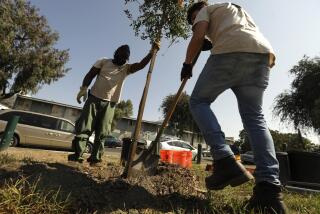Picturesque village goes out on a limb to stay so
- Share via
PEACHAM, VT. — In this hilltop hamlet, shade trees have always been part of the appeal.
For decades, giant elms, oaks, maples and butternuts towered over roads and homes, providing shade, fall foliage and a picturesque complement in a place that draws leaf peepers, photographers and the occasional filmmaker looking for a New England backdrop.
But disease, old age and storm damage have taken a toll in recent years. Now the town is embarking on a tree maintenance plan aimed at preserving what’s left -- taking inventory, propping up ailing trees and planting for the future.
It has drawn up a 100-year plan aimed at restoring the lush greenery that once canopied Bayley-Hazen Road and other roads, established a Village Tree Board and begun identifying the damaged trees that can be saved.
It’s a big job, and it won’t be done quickly.
“We have some sugar maples and oaks in the village that are in their last stages,” said Julie Lang, who chairs the Village Tree Board. “It’s a good time to be looking at these replacements and realize it’s not just an overnight initiative. It’ll take decades before we realize the canopies and the greenery we had 40 years ago.”
In Vermont’s rural communities, trees are often taken for granted.
Few residents have addressed the problem of aging trees, which can be dangerous when lightning or storms hit, according to Danielle Fitzko, urban and community forestry coordinator for the state Department of Forests, Parks and Recreation.
“People sometimes don’t look at trees as actual infrastructure, like roads and sidewalks, that need to be maintained and funded,” Fitzko said. “We enjoy them but don’t realize we have to be caring for them. What Peacham did is what we recommend -- doing an inventory and a management plan. They identified species, looked at condition and made a plan for how to move forward and how to actually manage this resource.”
For a place with 665 people and a $600,000 annual budget, it wasn’t easy.
After obtaining a $3,000 state grant to draw up a management plan, the village rustled up an equal amount in volunteer contributions and took stock of 400 trees, laying the framework for cabling and repair of 65 damaged ones and the future planting of flowering crabapple trees on the roads leading into the village.
Now, the town earmarks about $3,000 annually for trees, augmenting that with volunteer labor and other contributions. It’s a start.
Education is one element of the plan -- letting property owners know that there are less expensive, less destructive ways to save trees than to cut them down when they begin to have problems.
“It’s gotten so people have been afraid of their trees. A branch breaks off, and before you know it, they’re having a 40-inch maple that’s been there a hundred years ... taken down,” said Dave Jacobs, a landscape architect working as a volunteer in the effort.
Instead of spending $1,000 to tear down such a tree, it can take only a few hundred dollars to prune or cable the tree and render it safe, he said.
There are other benefits too.
“The aesthetic of a canopied street is that it gives the sense of a village, and it slows traffic down. It makes for a setting, a character. You’re driving through an open field of corn and suddenly you reach a place with houses and nice big trees canopying over the roadway,” Jacobs said.
Residents are behind the effort for various reasons.
“I want the road looking narrower so the cars go slower,” said Stan Fickes. “People drive 50 miles an hour in a 30 mile-an-hour zone in front of my house. I have five children.”
“It’s a beautiful little town, and the people here have wanted to keep the trees,” said Nancy Bundgus, 90. “I’m as old as some of them, you know.”
More to Read
Sign up for Essential California
The most important California stories and recommendations in your inbox every morning.
You may occasionally receive promotional content from the Los Angeles Times.













